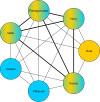Data Mining a Medieval Medical Text Reveals Patterns in Ingredient Choice That Reflect Biological Activity against Infectious Agents
- PMID: 32047130
- PMCID: PMC7018648
- DOI: 10.1128/mBio.03136-19
Data Mining a Medieval Medical Text Reveals Patterns in Ingredient Choice That Reflect Biological Activity against Infectious Agents
Abstract
The pharmacopeia used by physicians and laypeople in medieval Europe has largely been dismissed as placebo or superstition. While we now recognize that some of the materia medica used by medieval physicians could have had useful biological properties, research in this area is limited by the labor-intensive process of searching and interpreting historical medical texts. Here, we demonstrate the potential power of turning medieval medical texts into contextualized electronic databases amenable to exploration by the use of an algorithm. We used established methodologies from network science to reveal patterns in ingredient selection and usage in a key text, the 15th-century Lylye of Medicynes, focusing on remedies to treat symptoms of microbial infection. In providing a worked example of data-driven textual analysis, we demonstrate the potential of this approach to encourage interdisciplinary collaboration and to shine a new light on the ethnopharmacology of historical medical texts.IMPORTANCE We used established methodologies from network science to identify patterns in medicinal ingredient combinations in a key medieval text, the 15th-century Lylye of Medicynes, focusing on recipes for topical treatments for symptoms of microbial infection. We conducted experiments screening the antimicrobial activity of selected ingredients. These experiments revealed interesting examples of ingredients that potentiated or interfered with each other's activity and that would be useful bases for future, more detailed experiments. Our results highlight (i) the potential to use methodologies from network science to analyze medieval data sets and detect patterns of ingredient combination, (ii) the potential of interdisciplinary collaboration to reveal different aspects of the ethnopharmacology of historical medical texts, and (iii) the potential development of novel therapeutics inspired by premodern remedies in a time of increased need for new antibiotics.
Keywords: antibiotic resistance; antimicrobial agents; antimicrobial combinations.
Copyright © 2020 Connelly et al.
Figures



References
-
- Cameron ML. 2008. Anglo-Saxon medicine. Cambridge University Press, Cambridge, United Kingdom.
-
- Horden P. 2011. What’s wrong with early medieval medicine? Social History Med 24:5–25. doi:10.1093/shm/hkp052. - DOI
Publication types
MeSH terms
Substances
Grants and funding
LinkOut - more resources
Full Text Sources
Medical
